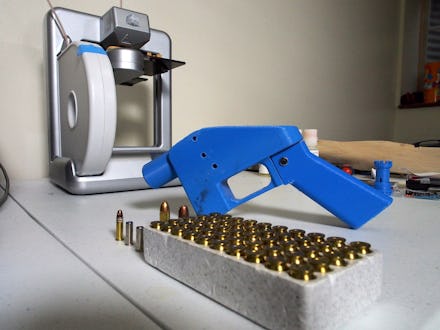Lawsuit moves to keep the blueprints for 3D printed guns off the web

Modern advancements in 3D printing technology have made it possible to produce fully functioning, deadly firearms, made entirely from plastic — all from the comfort of your own home. It’s a process that the government has strictly regulated in the past. Now, however, thanks to a legal settlement reached by the Trump administration, that might be about to change.
On Tuesday, three prominent gun safety groups announced that they are preparing legal action in the coming days to prevent the U.S. State Department from allowing the blueprints for 3D-printed guns to be posted online. In an amicus brief filed on July 24, attorneys representing the Brady Center to Prevent Gun Violence, Everytown for Gun Safety and the Giffords Law Center to Prevent Gun Violence objected to an imminent governmental rule change that would upend the regulatory structure governing firearm exports.
The shift stems from a settlement the government recently reached with Defense Distributed, a small, bullish nonprofit company that is believed to have posted the first set of online instructions on how to build a 3D-printable handgun in 2012.
The tangled mass of gun laws in play here goes back to 1988, when Ronald Reagan signed the Undetectable Firearms Act into law. The legislation made it illegal to manufacture, sell or possess any firearm “which is not as detectable ... by walk-through metal detectors” like those found in airport. This essentially banned firearms made from cheap polymers. Although the U.S. was decades away from honing the technology to 3D print plastic weapons when the law was written, it was renewed by the Clinton administration in 1998, by George W. Bush’s White House in 2003 and again by Barack Obama in 2013.
Shortly after Obama reauthorized the 1988 law, the government ordered Cody Wilson, the then-25-year-old owner of Defense Distributed, to take down the blueprints for 3D-printed firearms the company had posted online on the grounds that he had run afoul of the Undetectable Firearms Act.
In a 2013 interview with the New York Times, Wilson was recalcitrant about the order of removal. It wasn’t about increasing the number of firearms on the market, he argued — it was about reducing the government’s role in regulating new technologies.
“I don’t care about the project,” he told the Times of Defense Distributed in 2003. “This is about the future of the freedom of information and regulation of the internet.”
Soon afterward, Wilson filed suit against the State Department, arguing that by demanding he remove the blueprints from the internet, the government was infringing upon his Constitutionally-enshrined right to free speech.
After a protracted legal battle, the government offered to settle the Defense Distributed suit in April 2018, offering the company a special agreement to remove its 3D gun blueprints from the United States Munitions List and to allow “any United States person…to access, discuss, use, reproduce, or otherwise benefit” from the designs.
“[T]his settlement is far from ordinary,” the gun safety organizations wrote in the letter. “It is dangerous, irreparable and – as the government itself has emphatically argued for years – raises issues of national defense and national security of the highest order. It is also, we believe, illegal.”
In a New York Times op-ed piece, former U.S. Rep. Steve Israel, who has long been at odds with the gun lobby, wrote that while the settlement technically doesn’t reverse the Undetectable Firearms Act, it “undermines it by making it easier for terrorists, criminals and minors to quietly produce deadly weapons with an inexpensive 3-D printer.”
Thanks to the settlement, Defense Distributed now says it plans re-upload the blueprints for 3D-printed guns on Aug. 1, when the company says the, “age of the downloadable gun formally begins.”
According to the letter the three gun violence prevention groups submitted in court on Tuesday, the company’s plans only get grander from there. Wilson eventually hopes to expand the Defense Distributed website to contain “a repository of firearm blueprints for ‘more exotic DIY semi-automatic weapons,’ the letter claims. The company has allegedly had time to develop “a trove of other 3-D-printable weapon blueprints, including Assembly AR-15s and AR-10s,” which Wilson hopes to soon convert into a “searchable, user-generated database of practically any firearm imaginable.”
Jonathan Lowy, the vice president of litigation for Brady, told Mic in a phone interview that if Defense Distributed has its way, “anybody in the world with access to the internet and a 3D printer could make all of the undetectable assault weapons or other guns that they wanted.”
“That would include international terrorists, convicted felons — anybody,” Lowy added. “This would blow right open the loopholes for any national or international prohibitions on people that should not have guns.”